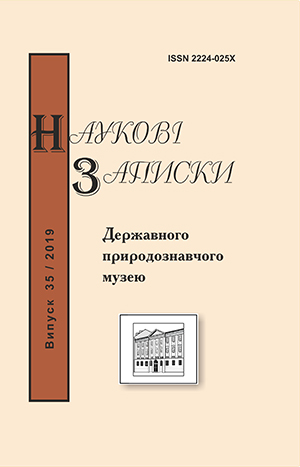Chernobay Yu.M.
To the history of the integrity and paradigm methodology of natural and social coevolution // Proc. of the State Nat. Hist. Mus. - Lviv, 2019. - 35. - P. 3-14 DOI: https://doi.org/10.36885/nzdpm.2019.35.3-14 Key words: Methodology of integrity, paradigm of coevolution, Lviv natural science school, High school in Dublyany, phytosociology, nature protection The regional phenomenon of the integrity methodology and natural-social coevolution, which took place in the scientific community of Lviv at the period of the end of 19th and the beginning of 20th century, was considered. The most prominent in creating this phenomenon were: V. Pol (preservation of cultural and natural heritage), V. Didushitsky (protection of certain species through environmental protection, natural motivation of self-identity), B. Dybovsky (taxonomy and continental biogeography), J. Pachoski (phytosociology and protection of nature), Y. Nusbaum-Gilarovich (philosophical and cognitive aspects of evolution), Y.G. Pavlikovski (nature and culture, theory and practice of nature conservation, the basics of tourist management). The emergence of this phenomenon led to the genesis of a number of scientific directions on the international level.
To the history of the integrity and paradigm methodology of natural and social coevolution // Proc. of the State Nat. Hist. Mus. - Lviv, 2019. - 35. - P. 3-14 DOI: https://doi.org/10.36885/nzdpm.2019.35.3-14 Key words: Methodology of integrity, paradigm of coevolution, Lviv natural science school, High school in Dublyany, phytosociology, nature protection The regional phenomenon of the integrity methodology and natural-social coevolution, which took place in the scientific community of Lviv at the period of the end of 19th and the beginning of 20th century, was considered. The most prominent in creating this phenomenon were: V. Pol (preservation of cultural and natural heritage), V. Didushitsky (protection of certain species through environmental protection, natural motivation of self-identity), B. Dybovsky (taxonomy and continental biogeography), J. Pachoski (phytosociology and protection of nature), Y. Nusbaum-Gilarovich (philosophical and cognitive aspects of evolution), Y.G. Pavlikovski (nature and culture, theory and practice of nature conservation, the basics of tourist management). The emergence of this phenomenon led to the genesis of a number of scientific directions on the international level.
References
- Bakhtin M.M. Formy vremeni i khronotopa v romane. Ocherki po istoricheskoi poetike // Voprosy literatury i estetiki. – M.: «Khud. lit.», 1975. – S. 234-407. [In Russian]
- Vernadskii V.I. Biosfera. – M.: Nauka, 1967. – 376 s. [In Russian]
- Holubets M.A. Seredovyshcheznavstvo (invaironmentolohiia). – Lviv: «Manuskrypt», 2010. – 176 s. [In Ukrainian]
- Zlupko S. Ekohomolohiia – novyi naukovyi napriam suchasnosti (prychyny i umovy formuvannia) // Rehionalna ekonomika. – 2004. – № 3. – S. 33-44. [In Ukrainian]
- Mamford L. Myf mashynы. Tekhnyka y razvytye chelovechestva. – M.: Lohos, 2001. – 408 s. [In Ukrainian]
- Odum G., Odum E. Energeticheskii bazis cheloveka i prirody. – M.: Progress, 1978. – 380 s. [In Russian]
- Pachoskii I.K. Metod klassifikatcii i edinstvo nauk. – Kiev: Tipogr. gaz. "Kievskoe slovo", 1891. – 88 s. [In Russian]
- Pachoskii I.K. Osnovy fitosotciologii. Kurs, chitannyi na agronomicheskom fakultete Khersonskogo politekhnicheskogo instituta v 1919-1920 g. – Kherson: Izd. stud. komit. s-kh. tekhnikuma, 1921. – 346 s. [In Russian]
- Pachoskii I.K. Sotcialnyi printcip v rastitelnom tcarstve // Zhurnal russkogo botanicheskogo obshchestva, 1925. – T. 10. – S. І-KhІІІ. [In Russian]
- Podolinskii S.A. Trud cheloveka i ego otnoshenie k raspredeleniiu energii // "Slovo". – Sankt-Peterburg, 1880. – № 4/5. – S. 135-211. [In Russian]
- Podolynskyi S.A. Vybrani tvory. – K: KNEU, 2000. – S. 281. [In Ukrainian]
- Puzanov I.I., Gold T.M. Vydaiushchiisia natupalist I.K. Pachoskii. – M.: Hauka, 1965. – 88 s. [In Russian]
- Chernobai Yu.M. Fenomen V. Didushytskoho u tendentsiiakh novitnoi muzeolohii // Nauk. zap. Derzh. pryrodozn. muzeiu. – Lviv, 2015. – Vyp. 31. – S. 3-14. [In Ukrainian]
- Chernobai Yu. Lokalne i hlobalne v muzeinykh khronotopakh V. Didushytskoho ta B. Dybovskoho // Zb. "Profesor Benedykt Dybovskyi – vyznachnyi doslidnyk spilnoi pryrodnoi spadshchyny Polshchi, Bilorusi ta Ukrainy". – Lviv: "Imperial", 2018. – S. 148-167. [In Ukrainian]
- Chornobai Yu.M. Pryrodoznavstvo i rehionalnyi pryrodnycho-informatsiinyi prostir // Nauk. zap. Derzh. pryrodozn. muzeiu. – Lviv, 1998. – T. 14. – S. 6-15. [In Ukrainian]
- Brzęk G. Muzeum im. Dzieduszyckich we Lwowie i jego Twórca. – Lublin: Wyd-wo Lubelskie Nowe, 1994. – 200 s.
- Czarnobaj J., Boruszczak M. Doświadczenia W. Hr. Dzieduszyckiego, a współczesne trendy komunikacji muzealnej // Jan Gwalbert Pawlikowski. Humanist. Wizia ochrony przyrody i turystyki. – Kraków: Gen. Ośr.Turystyki Górskiej PTTK, 2014. – S. 241-254.
- Dyakowski B. Badacz dalekiej Północy. – Warszawa: KONTRAST, 2003. – 69 s.+8 zdięć.
- Dzieduszycki W. Przewodnik po Muzeum im. Dzieduszyckich we Lwowie. – Lwów, 1895. – 238 s.


